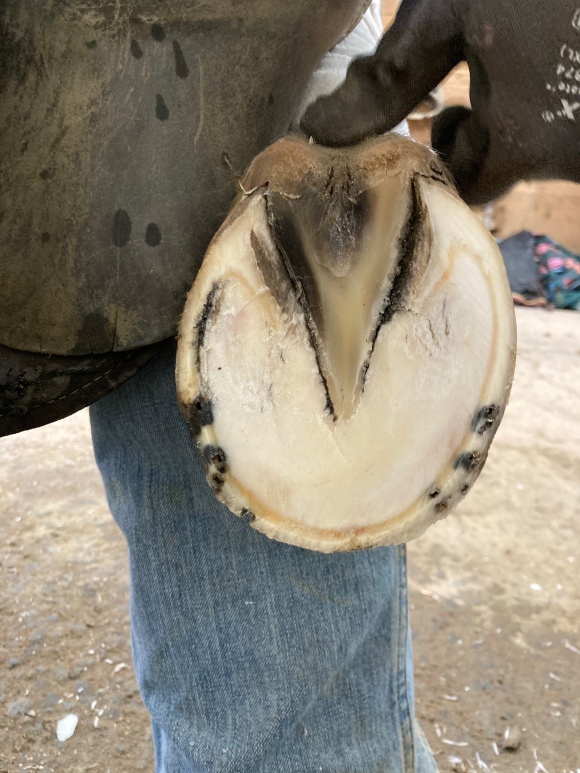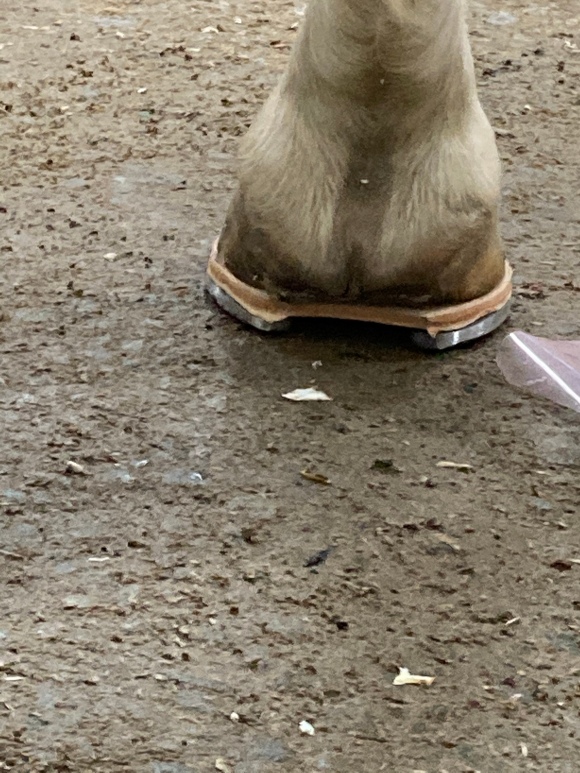If you’ve been looking at photographs here, you’ve seen some casts on horses feet. Casts can serve many purposes in hoof rehabilitation, such as:
- creating a false wall to nail into
- limiting hoof mechanism when managing sheared heel syndrome
- safely covering abscess holes, resections and surgery sites to keep them clean
- protecting thin soles
- offering a very sturdy way to hold in hoof packing of any type
- protecting a foot when we’ve had to trim it particularly short
- holding the hoof together to help limit the direction tubules are bending towards after a major distortion
- a quick fix when a shoe has come off and the wall has torn into the soft tissue
- laminitic horses after they are stabilized
They are also convenient for a primarily barefoot horse who may occasionally become a little tender but there’s no pathology and shoes are not warranted. We find that when used for the correct application, most horses are instantly sound after being cast. This gives them an advantage over many modalities including shoes, which cannot always be applied to a painful horse or a horse with little foot to work with.
The casts we use on horses are the exact same casting material used for human hard casts but cut into different sizes. Size choice is based on how large the hoof is and what we are trying to accomplish. For example, Mike is nailing into a cast, we trim together, determine shoe placement and then Gayle casts the horse according to the pathology we are dealing with. Mike then nails the shoe as if the cast were not there. The size of cast is based on how much fake wall we are trying to create and how much cast Mike can nail through.
A cast should never be applied over a hoof that is not prepped correctly, with the exception being a rim cast that is intended to fall off within a few days. Otherwise the procedure is as follows:
- trim foot
- do either a White Lightening or CleanTrax treatment
- dry on clean shavings for at least two hours
- freshen trim
- lightly sand outside of foot
- apply Equipack if using
- glue outside of foot and sole if necessary
- carefully apply cast
- wet cast thoroughly
- wrap in plastic wrap tightly
- allow to cure for 15 minutes
- if shoeing, shoe now
- remove plastic and ideally horse stays in stall for a few hours or overnight
Proper tension is critical when casting, along with never going over the coronary band or heel bulbs. Too loose and the cast will not stay on, too tight and it will potentially cut circulation off. Casting is like a lot of things, the concept is simple but the actual application is tricky.
Because we trim and disinfect the foot before applying the cast, and then glue it, the hoof is now clean inside of it and mostly waterproof also. Most casts will stay on 3-4 weeks. Longer than that is not ideal, as the foot is not wearing at all inside of it while being stimulated to grow rapidly. Casting is usually the quickest way to grow foot as fast as possible.
Horses usually handle the casting process well. Once the foot has been glued and the cast is being applied there are only a few moments to finish up and get it wrapped before the cast begins to set, so the horse must allow that work to be done without pulling their foot away. The plastic wrap makes a predictably creepy sound so we make sure they are ok with that first. The water hitting the foot sometimes startles them. If there is any concern at all about a horses ability to handle this it is best to mildly sedate them so we don’t waste a lot of casts trying to get one on. After the first one or two most horses pay no attention to it at all.
Like a good shoeing job, a cast should look natural on a foot and not be bulky or uneven. They can be rasped after being cured but that may affect the integrity and strength of the cast so we try to not do that unless absolutely necessary.


